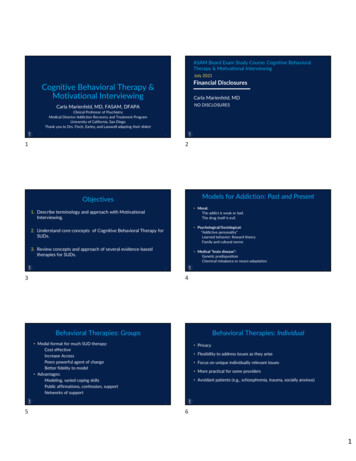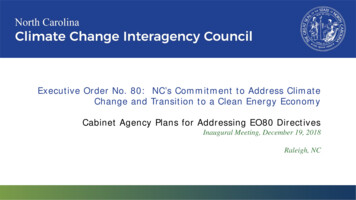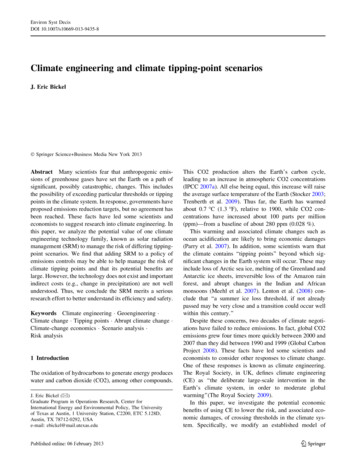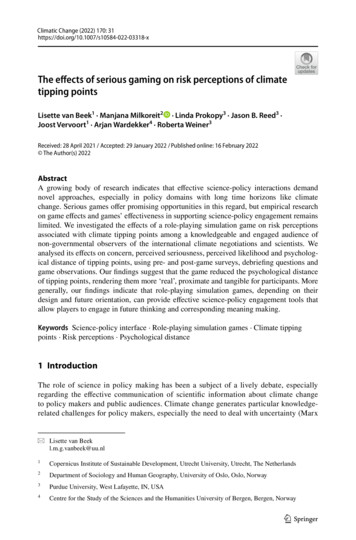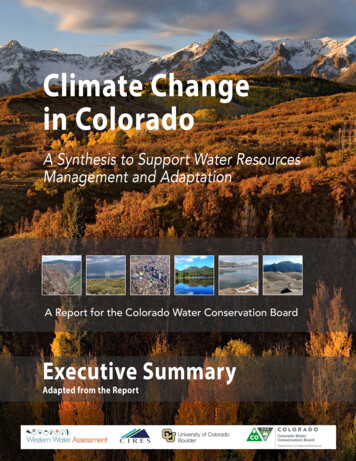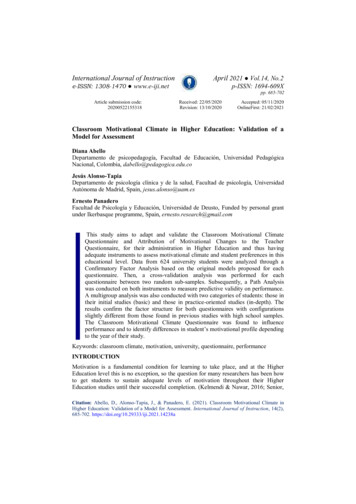
Transcription
International Journal of Instructione-ISSN: 1308-1470 www.e-iji.netArticle submission code:20200522155318April 2021 Vol.14, No.2p-ISSN: 1694-609Xpp. 685-702Received: 22/05/2020Revision: 13/10/2020Accepted: 05/11/2020OnlineFirst: 21/02/2021Classroom Motivational Climate in Higher Education: Validation of aModel for AssessmentDiana AbelloDepartamento de psicopedagogía, Facultad de Educación, Universidad PedagógicaNacional, Colombia, dabello@pedagogica.edu.coJesús Alonso-TapiaDepartamento de psicología clínica y de la salud, Facultad de psicología, UniversidadAutónoma de Madrid, Spain, jesus.alonso@uam.esErnesto PanaderoFacultad de Psicología y Educación, Universidad de Deusto, Funded by personal grantunder Ikerbasque programme, Spain, ernesto.research@gmail.comThis study aims to adapt and validate the Classroom Motivational ClimateQuestionnaire and Attribution of Motivational Changes to the TeacherQuestionnaire, for their administration in Higher Education and thus havingadequate instruments to assess motivational climate and student preferences in thiseducational level. Data from 624 university students were analyzed through aConfirmatory Factor Analysis based on the original models proposed for eachquestionnaire. Then, a cross-validation analysis was performed for eachquestionnaire between two random sub-samples. Subsequently, a Path Analysiswas conducted on both instruments to measure predictive validity on performance.A multigroup analysis was also conducted with two categories of students: those intheir initial studies (basic) and those in practice-oriented studies (in-depth). Theresults confirm the factor structure for both questionnaires with configurationsslightly different from those found in previous studies with high school samples.The Classroom Motivational Climate Questionnaire was found to influenceperformance and to identify differences in student’s motivational profile dependingto the year of their study.Keywords: classroom climate, motivation, university, questionnaire, performanceINTRODUCTIONMotivation is a fundamental condition for learning to take place, and at the HigherEducation level this is no exception, so the question for many researchers has been howto get students to sustain adequate levels of motivation throughout their HigherEducation studies until their successful completion. (Kelmendi & Nawar, 2016; Senior,Citation: Abello, D., Alonso-Tapia, J., & Panadero, E. (2021). Classroom Motivational Climate inHigher Education: Validation of a Model for Assessment. International Journal of Instruction, 14(2),685-702. https://doi.org/10.29333/iji.2021.14238a
686Classroom Motivational Climate in Higher Education:Validation et al, 2018). According to Achievement goal theory (Ames & Archer, 1988; Nicholls,1989), students engage in academic activities for different reasons. This fact implies theexistence of different motivational orientations: a) Mastery orientation, when thestudent’s goal is to master a skill or content; b) Performance orientation, when thestudents’ goal is to demonstrate that they perform better in comparison to others or tothe pre-established standard, and c) avoidance orientation, if students act trying not toappear less smart that their peers. In short, the students’ motivational orientationinfluences their learning process and academic performance (Cellar, et al, 2011; Meece,Anderman, & Anderman, 2006; Vandewalle, Nerstad, & Dysvik, 2019).While each student has a motivational orientation of his/her own, each particularclassroom influences the type of goal the student sets specifically for that class. Thestudents’ perception of the class influences the goals they choose and allows evaluationof what is known as classroom motivational climate, a climate shaped by the teacher’sactions (Alonso-Tapia, 2016; Alonso-Tapia & Fernández-Heredia, 2008; Gutiérrez &Tomás, 2018; Corkin, Horn & Pattison, 2017). One of the main characteristicsinfluencing the type of motivational orientation a student adheres to, in a given class, ismarked by the way objectives or goals are structured in the classroom (Rolland, 2012).Classroom goal structures are defined by the type of achievement objectives pinpointedby the teacher during their pedagogical practice in a learning environment. Currentresearch has focused on three types of goal: Mastery goals, which emphasize theacquisition of knowledge or the development of competencies; performance/resultgoals, which emphasize demonstrating competence in comparison with others or withthe standard; and avoidance goals, which emphasize not looking bad in front of others(Kadioglu & Uzuntiryaki-Kondakci, 2014; Meece et al., 2006; Patrick, Kaplan, & Ryan,2011). Thus, classroom goal structures and the motivational climate are complementaryconcepts that facilitate the identification of how the teacher’s actions influenceachievement in educational environments (Bardach, Oczlon, Pietschnig, & Lüftenegger,2019).The importance of the classroom motivational climate and its influence on learningprocesses and academic performance have been observed in several studies (Rolland,2012; Kadioglu & Uzuntiryaki-Kondakci, 2014; Corkin, et al., 2017). Students’perceptions of motivational climates predict the personal goals students adopt for class,so classroom climates focused on learning and mastery are considered facilitators ofmotivational orientations toward the same type of objective.The motivational climate is specific to each classroom and is configured mainly throughthe teacher’s actions (Alonso-Tapia, 2016). This fact means that teachers differ fromeach other in the way they organize the class activities and in their communication withthe students. Besides, teachers’ action patterns have motivational implications, as will beshown in the next section. Therefore, the differences pointed create a specificmotivational climate for each classroom, that favors or hinders students’ motivation tolearn, and thus, it is important to recognize, in each classroom, how the motivationalclimate is actively being configured and which teacher actions are facilitating orInternational Journal of Instruction, April 2021 Vol.14, No.2
Abello, Alonso-Tapia & Panadero687hindering the generation of a motivational climate of mastery that favors learning inHigher Education classrooms.Although the importance of identifying and working on the classroom motivationalclimate is widely acknowledged, studies on this construct in Higher Education areincipient. Although there are some studies on this educational domain (Ahmad & Rana,2011; Gutiérrez & Tomás, 2018; Zlate & Cucui, 2015), they are not as comprehensiveas those at other educational levels, which poses questions about the motivational needsof Higher Education students in the classroom and what are the most appropriateteaching strategies to work with students in this context.To understand the ideal characteristics of the Higher Education classroom motivationalclimate, it is necessary to clarify the theoretical assumptions that form the basis of“classroom motivational climate,” as well as the instruments required to evaluate it.Classroom Motivational ClimateThe concept of classroom motivational climate has its roots in two sources. The first isbased on the theories of goal orientation related to achievement, and the second, on theconcept of school climate and its typologies.The theory of goals related to achievement (Nicholls, 1989) proposes that the mainobjective in achievement contexts is to succeed in mastering a skill or knowledge or todemonstrate skill or knowledge. Within these objectives, there are two differentconceptions of skill. Underlying the objective of succeeding in mastering is a conceptionof skill as a modifiable attribute and the product of effort, whereas where the objectiveis to demonstrate, skill is conceptualized as a relatively stable trait whose existence isdemonstrated when one succeeds and surpasses others. Students who have the firstconception seek to learn, whereas those who have the second seek to demonstrate theirability or to prevent others from perceiving that they lack ability. Although there is apersonal predisposition toward one type of goal or another, it is influenced by contextualfactors defining the classroom motivational climate (Ames, 1992; Alonso-Tapia, Ruiz &Huertas, 2020), which is part of the wider school climate.Applying organizational climate theories to the educational context has led to thedefinition of a school climate (Anderson, 1982), a macro-climate that includes theclassroom as one of its subsystems, the place where teachers and students interact andwhere the teaching process takes place. The classroom climate includes more specificsub-climates (Alonso-Tapia, et al, 2020; Djigic & Stojiljkovic, 2011; Goldenberg &Klavir, 2017): the academic-motivational climate, the emotional climate, thedisciplinary climate (all of which depend on teacher action), and the climate ofcoexistence or peer support Underlying this, the motivational climate is understood asthe set of teacher actions that can influence the orientation of student motivation towardlearning (Ames, 1992).The existence of a motivational climate oriented toward a task or mastery is facilitatedwhen the teacher emphasizes improving personal achievements, assessing individualeffort and learning (Ames, 1992) through action guidelines, by introducing learningInternational Journal of Instruction, April 2021 Vol.14, No.2
688Classroom Motivational Climate in Higher Education:Validation activities during their course work and at the time when the assessment takes place(Alonso-Tapia et al., 2020). When this happens, the student focuses on acquiring newskills or perfecting those they have already acquired to achieve their mastery. Thisclimate fosters adaptive motivational responses in the student, such as greater interestand satisfaction with learning and academic activity, greater perception of self-efficacy,and attributions of effort-centered success. By contrast, a performance climate,involving the ego, occurs when the teacher encourages comparisons between one studentand another, or with a regulatory standard whereby the success of students is judged inrelation to the performance of others. This makes the student perceive that the academicprocess is oriented toward demonstrating competence, a perception generatinginadaptive motivational responses, such as disinterest in learning, anxiety regardingassessment, choosing tasks based only on the probability of success, and attribution ofsuccess to ability or failure to the lack of it that leads to, perceiving ability as a stablefactor.Works such as that by Lerdpornkulrat, Koul, and Poondej (2018) show how contextualfactors, especially aspects related to teaching, can significantly influence a student toadopt a goal related to either mastery or performance. It is argued that if we want toimprove the level at which our students engage in learning activities, and the likelihoodthat they will pursue mastery challenges, overcome the obstacles they face, andsuccessfully complete academic activities, it is necessary to ask ourselves how it ispossible for the teacher to develop actions to actualize motivational climates orientedtoward mastery. To answer this question, however, it is necessary to know whichspecific action guidelines the teacher should change, which poses the problem ofspecifying the classroom motivational climate construct in an assessment instrument.Among the different instruments that have been proposed to measure it, the ClassroomMotivational Climate Questionnaire (CMCQ) (Alonso-Tapia & Fernández-Heredia,2008) stands out. This instrument gathers the ideas developed by Alonso-Tapia andPardo (2006), in line with the approaches of Ames (1992) and Urdan and Turner (2005).The authors summarize a set of teaching strategies that can be organized around thedifferent moments that occur during a class, and whose effectiveness has been shown toimprove motivation toward learning. These strategies are summarized and shown inFigure 1. The CMCQ has been used widely in the Ibero-American context, showingadequate levels of reliability and a consistent theoretical structure; however, there are noreports of its use in Higher Education. The CMCQ can be applied simultaneously withthe Attribution of Motivational Changes to the Teacher Questionnaire (AMCT-Q),which acts as a complementary questionnaire that allows identifying the students’attribution of degree of positive change experienced in their success expectancies,interest in the subject, perceived ability, effort disposition. self-regulation andsatisfaction with teacher’s work.International Journal of Instruction, April 2021 Vol.14, No.2
Abello, Alonso-Tapia & Panadero689Figure 1Classroom motivational climate elements (Alonso-Tapia, 2020)Since neither of the two mentioned instruments has been validated in a HigherEducation context, this study aims to adjust and validate the CMCQ and the AMCT-Qfor its application in this context. The importance of the validation of the CMCQ atHigher Education relies on the fact that it would help teachers to identify their teachingpatterns that are adequate for motivating the students, as well as those that should bemodified due to their negative effects. As for the AMCTQ, it provides an index ofchanges that students attribute to professors and so is a validation measure that can beused in intervention studies. As for the starting hypotheses, they are based on the resultsthat both instruments have produced in other contexts. First, we expect that adequatelevels of structural validity will be reached, in line with the structure proposed byAlonso-Tapia and Fernández (2008; Alonso-Tapia, 2016), and that adequate values ofreliability will be reached. Second, we expect to find differences between thepreferences of Higher Education students and those of students at other educationallevels. It is possible that students perceive motivational climates as more orientedtoward performance, since the context of Higher Education classrooms is highlycompetitive, and students perceive a lot of pressure to perform, giving important weightto the grades obtained.METHODSampleA total of 624 students from the Universidad Pedagógica of Colombia participated inthe study. They came from 38 different groups, all of which received classes in a total of25 different subjects. Of the students, 94.6% were women, and 5.4% were men, betweenthe ages of 17.1 and 40.5 years old (M: 22.5; SD: 3.6), and 96.3% came from lower andInternational Journal of Instruction, April 2021 Vol.14, No.2
690Classroom Motivational Climate in Higher Education:Validation middle-class backgrounds, and the percentages were representative of the university’spopulation configuration.InstrumentsThe Classroom Motivational Climate Questionnaire (CMCQ) (Alonso-Tapia &Fernández-Heredia, 2008). The CMCQ is a 32-item questionnaire gathering 16 patternsof teacher action related to the beginning of the class, the development of the class, andthe time the assessment is conducted. When used together, these patterns (Figure 1)invite the student to adopt mastery or learning goals (Alonso-Tapia & FernándezHeredia, 2008). Teachers can use each pattern to a different degree, which, in turn,generates the classroom motivational climate. Each pattern is assessed through twoitems, one with a positive statement and the other with a negative statement, on a fivepoint Likert scale on which the student must indicate their degree of agreement. Thequality of the questionnaire is substantiated by numerous studies conducted with morethan 10,000 students in middle and higher school, and non-university adults; the studiescollected are mostly by Alonso-Tapia (Alonso-Tapia et al 2020), with reliability indicesranging between .92 and .98Attribution of Motivational Changes to the Teacher Questionnaire (AMCT-Q). Thepurpose of this questionnaire is to identify the degree to which the student attributes tothe teacher the changes they have perceived in themselves throughout the class. Thisquestionnaire complements the CMCQ in that the former allows for identifying thestudent’s perception of the strategies the teacher employs in the classroom, whereas theAMCT-Q helps to identify the extent to which the student considers that these teacherstrategies positively or negatively influence their progress in the classroom. It has sixsubscales to measure the degree to which change is attributed to the teacher: 1) insuccess expectancies; 2) in interest in the subject; 3) in perceived ability; 4) in effortdisposition; 5) in self-regulation; 6) in satisfaction with teacher’s work. It has been usedin several studies, where adequate levels of reliability are reported in its scales, withvalues between .65 and .91 (Alonso-Tapia, et al, 2020; Leal-Soto & Alonso-Tapia,2017; Villasana & Alonso-Tapia, 2015). Just as with CMCQ, the AMCT-Q has not beenused or validated in a Higher Education population.ProcedureProcedure for linguistic and cultural adjustment. The linguistic and cultural adjustmentprocess was carried out based on the procedures described by Beaton, Bombardier,Guillemin, and Ferraz (2000) in four phases: 1) the review and adjustment of theinstruments in their Spanish version by a group of experts; 2) a review of linguisticadjustments by the authors of the original version; 3) a pilot test with a group of finalyear university students; 4) a final review of the adjustments by the original authors.Application procedure. Once the procedures are presented to the faculty researchcommittee, the study was made known to teachers and students who were invited toparticipate voluntarily. The questionnaires were completed by the students on paperduring the class.International Journal of Instruction, April 2021 Vol.14, No.2
Abello, Alonso-Tapia & Panadero691Data AnalysisPrior to conducting the analyses, cases with 5% or more of missing data wereeliminated. In the remaining cases, where the missing data may be due to chance, thesewere replaced by the items mean score, a decision that generates less error.Then, to discover the psychometric properties of the CMCQ and the AMCT-Q,confirmatory factorial analyzes were carried out to test the suitability of the modelproposed for each questionnaire, and the models based on previous studies carried out inother countries, as described above. For the analysis, the sets of data were dividedrandomly into two subsamples. Factorial analysis was conducted on the first subsample,and the second sample was used to perform cross-validation that allows isolating themodel’s behavior once restrictions are imposed on the equality of parameters in themeasurement weights. The estimation method used was Maximum Likelihood, and sixmodel fit indices were considered: χ2/gl 5; GFI, IFI, and CFI 0.90; RMSEA 0.08;SRMR 0.08. Once the model with the highest degree of fit was determined, areliability analysis was performed using the Omega index (McDonald, 2013).To study the questionnaires’ concurrent/predictive validity, route analysis was usedemploying the CMCQ as predictor variable and the AMCT-Q and the final gradeobtained in the course as criterion variables.Finally, a multigroup analysis was carried out with two categories of students, those intheir initial studies (basic) and those in practice-oriented studies (in-depth), with thepurpose of determining whether the stage of study influenced both the measurementmodel and the validity of the instruments.FINDINGS AND DISCUSSIONCMCQ Factorial AnalysisRegarding the structure of the test, a single construct is observed as a classroommotivational climate toward learning manifested in the 16 action guidelines (Figure 2).When observing the goodness-of-fit indicators shown in Table 1, we find that the modeladequately fits the data. Although the p-value of χ2 is higher than expected, this isexplained by the sample size, but χ2/ df is less than 5, so it is acceptable. The remainingindicators exceed acceptable fit values.In the cross-validation analysis, acceptable values are also observed in all indicators,even when restrictions are imposed on the equality of parameters in the measurementweights (χ2 20.026, p 0.171). Therefore, the model is well-estimated and can beaccepted. The reliability score is high, ω 0.97. The data show that the CMCQ isadequate and reliable for measuring classroom motivational climate in the ColombianHigher Education context and maintains the original structure posited by the authors.International Journal of Instruction, April 2021 Vol.14, No.2
692Classroom Motivational Climate in Higher Education:Validation Figure 2Original CMCQ model: Standardized measurement weightsTable 1Goodness-of-fit indicators of CMCQ modelAFCχ2dfPCMCQ original modelN 314260.69105CMCQ cross-validationN 314 / 313546.35225χ2/dfCFI.94RMSEASRMR .001 2.48TLI.93.07.056 .001 2.43.94.94.05.057Factorial Analysis of the AMCT-QFigure 3 shows the factor structure of the AMCT-Q. Table 2 shows the goodness-of-fitindicators that are adequate. Whereas the p-value of χ2 is higher than expected, this isexplained by the sample size, but χ2/ df is less than 5, so it is acceptable.International Journal of Instruction, April 2021 Vol.14, No.2
693Abello, Alonso-Tapia & PanaderoTable 2Goodness-of-fit indicators of the original AMCT-Q model and cross-validation analysisAnalysesχ2dfOriginal model N 313572.90Cross-validation N 313 /311Pχ2/dfCFIRMSEASRMR205 .001 2.80TLI.92.92.08.051123.33 436 .001 2.57.92.92.05.06Figure 3Original AMCT-Q model, standardized measurement and structural weightsThe cross-validation multigroup analysis also shows acceptable values in all indicators,even when restrictions are imposed on equal parameters in measurement weights (χ 2 15.323, p 0.501), in structural weights (χ2 19.479, p 0.554), in structuralcovariances (χ2 19.801, p 0.596), and in structural residuals (χ2 22.827, p 0.643). Therefore, the model is well-estimated and can be accepted.Regarding the reliability of the six scales and of the complete instrument, the indices areadequate, as can be seen in Table 3.Overall, the data show that the structure of the AMCT-Q questionnaire corresponds tothat expected and that its reliability is adequate, which allows this version to be acceptedfor use in research or intervention in the Colombian Higher Education context.International Journal of Instruction, April 2021 Vol.14, No.2
694Classroom Motivational Climate in Higher Education:Validation Table 3AMCT-Q reliability data based on the original modelScaleItemsΩAttribution of changes to the teacher (complete questionnaire)22.99Success expectancies attributed to teacher’s work3.85Interest attributed to teacher’s work3.89Perceived ability attributed to teacher’s work3.89Effort disposition attributed to teacher’s work3.88Self-regulation change attributed to teacher’s work6.94Satisfaction with teacher’s work4.85Concurrent and Predictive Validity of the Classroom Motivational ClimateQuestionnaire in The Higher Education ContextTo establish concurrent validity, the relationship of the CMCQ with the AMCT-Q as awhole was analyzed, while at the same time, its ability to predict academic performancewas analyzed (final course note). For both purposes, a route analysis was performedusing the AMCT-Q as a moderating variable and performance as a criterion. It was onlypossible to obtain the academic grades of 397 students. The reduction with respect to theoriginal sample is because the system does not record the final grade due to enrollmentproblems, semester or course cancelation.Figure 4 shows the prediction weights and Table 4 shows the fit indices. As can be seen,the data exhibit a good fit to the model, since all the indicators obtain values consideredgood, RMSEA being the only one that presents an acceptable value; therefore, weassume the model can be accepted. The relationship of the CMCQ with the AMCT-Qshows a 44% variance in common, which implies that students recognize the positivevalue of how teacher’s respond (CMCQ) on the change in the different motivationalindicators that were assessed by the AMCT-Q. In terms of predictive validity, the directeffect of CMCQ on performance is significant, but low (2.25% variance explained),whereas the indirect effect is near to zero.Table 4Goodness-of-fit indicators of CMCQ predictive model on student satisfaction andacademic ictiveModel N 397561.419288 .0012.46.937.943.061.040International Journal of Instruction, April 2021 Vol.14, No.2
695Abello, Alonso-Tapia & PanaderoFigure 4Predictive model of classroom motivational climate (16 scales) on student satisfactionand academic performanceAnalysis of the effect of the theoretical or practical orientation at the time of thestudiesA multigroup analysis was carried out to identify if there were differences between thestudents of the basic cycle (semesters 1 to 6) and those of the in-depth cycle (7 to 10).This division is specific to the university in the curricula, and marks the moment whenstudents begin their internships, when they have to choose the path they will follow.The fit indices (Table 5) are similar to those found with the sample used in the routeanalysis, which evidences that the model is adequate in both cases. However, there aredifferences when equality restrictions are imposed on measurement weights, whichimplies that not all classroom motivational climate indicators have the same value forstudents according to whether they are at one level of study or another. To see in whichcases the differences occur, the Z statistic developed by Clogg, Petkova, and Haritou(1995) has been used.Table 5Indicators of goodness-of-fit of the multigroup analysis as a function of the theoreticalor practical orientation of the level of studiesAnalysisMultigroup analysisN 244 / 153χ2dfpχ2/dfTLICFIRMSEASRMR919.286456 .0012.016.915.923.051.047International Journal of Instruction, April 2021 Vol.14, No.2
696Classroom Motivational Climate in Higher Education:Validation As can be seen in Table 6, the data surpass the critical level ( 1.96) in five cases. On theone hand, for initial-level students (basic), clarity of organization and relaxed pace ismore related to a learning-oriented classroom climate than in the case of practiceoriented students (in-depth). For students at the higher level, the fact that the teacherindicating what will be learned by the students doing it and illustrating it with examplesis more related to the perception of a climate oriented toward learning than in the case ofstudents at the initial level.Table 6Analysis of differences between slopes. Z statistic by Clogg, et al. .00Diff.00ZInterestAMCT1.00Expectations of resultsAMCT.59.05.00Perceived skillAMCT.84.04InterestAMCT1.00Expectations of resultsAMCT.59.05.65.06-.06 1.10Perceived ve previous knowledgeCMC.86.07.71.09.151.75Relates topicsCMC.78.07.92.10-.14 1.73Promotes participationCMC.84.07.94.10-.10 1.29Messages toward learningCMC.85.071.06.11-.21 2.53Clarity of objectiveCMC.98.08.85.10.141.46Clarity of organizationCMC1.01.09.80.09.212.26Promotes autonomyCMC.88.07.83.09.06.73Teaches step by stepCMC1.07.09.91.10.161.68Provides examplesCMC.81.071.07.11-.27 3.15Gives feedbackCMC.84.08.99.11-.14 1.57The pace is relaxedCMC1.09.08.58.08.516.02Assesses for learningCMC.89.09.83.11.05.55Gives frequent praiseCMC.86.08.79.09.06.72Treats everyone fairlyCMC.80.07.74.10.06.71Dedicates attention to 50.00.001.001.00 1.12International Journal of Instruction, April 2021 Vol.14, No.2
Abello, Alonso-Tapia & Panadero697The fact that students value the teacher’s impact on their own learning and motivationhighly positively shows evidence in favor of the usefulness of the model. Each of theCMC scales investigates specific teaching patterns which importance for creating aCMC learning oriented has been suggested from authors of different theoreticalorientations: behavioral theories, intrinsic motivation theories, and social-cognitivetheorist (Patrick, Turner & Strati, 2016). The suggested patterns have been integrated inthe CMC following in some measure the sequence that instruction should follow withany kind of task. For example, the use of novel tasks that arouse curiosity and show theirintrinsic and extrinsic value can favor students’ engagement in the task; the activation ofprevious knowledge can help the students to feel that they have enough knowledge toperform the new task, which favor their sense of competence and their successexpectancies. In a similar way, the remaining CMC patterns, if implemented by teachers,change the classroom dynamics, and can help to improve the student motivation to learn(Alonso-Tapia, 2016). These implications highlight the importance of the teacher’s workin achieving high levels of quality in education. It shows clearly that it is necessary forHigher Education teachers to be attentive to the effect of their actions on studentmotivation as a key variable in the educational process.An important element in achieving classroom motivational climates focused on learningis that the teacher presents a clear organization that allows the student to identify thecourse structure and learning objectives, in accordance with other studies carried out inHigher Education (Antoniou & Kalinogloua, 2013; Senko, 2019).Feedback on performance in class activities, autonomous work, and tests are valuedhighly by students and help them be more focused on learning than grades. These resultsgain importance in light of other research in the Higher Education context, in which theimportance of feedback for the tr
2012; Kadioglu & Uzuntiryaki-Kondakci, 2014; Corkin, et al., 2017). Students' perceptions of motivational climates predict the personal goals students adopt for class, so classroom climates focused on learning and mastery are considered facilitators of motivational orientations toward the same type of objective.



